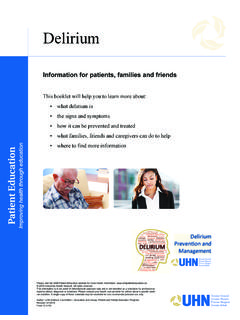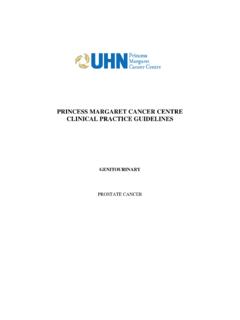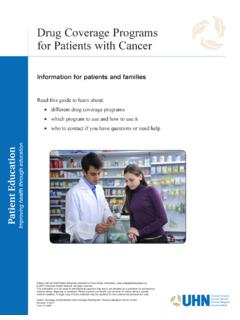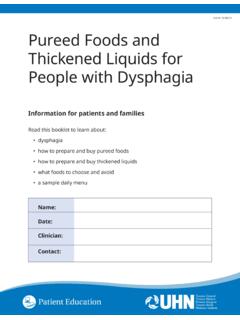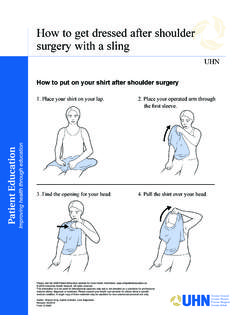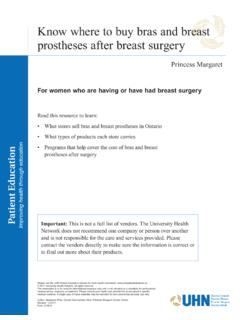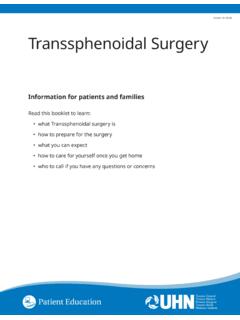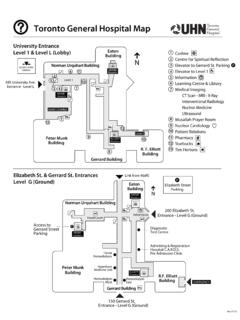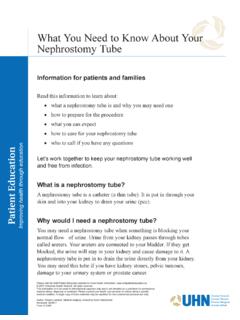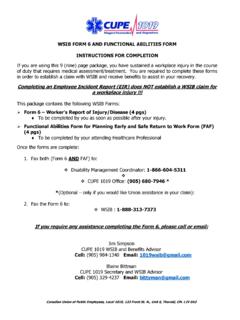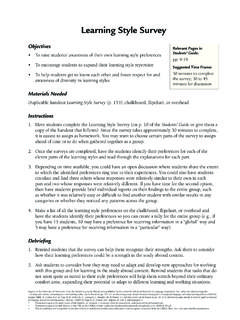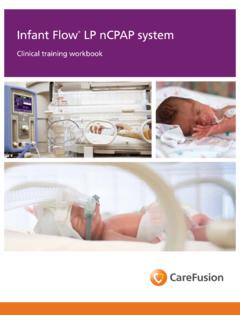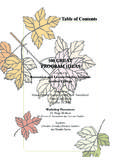Transcription of Functional Rehab After Breast Cancer Surgery
1 Form: D-5590. Functional Rehab After Breast Cancer Surgery A guide for patients who had a lumpectomy, mastectomy, sentinel node biopsy or axillary node dissection Read this information to learn: How you can expect to feel What daily activities you can do What exercises to do After your Surgery How scar massage can help Other helpful resources How can I expect to feel? Pain or numbness After your Surgery , you may have sharp pains, feel pins and needles or be more sensitive on the side of your body where you had your Surgery . You may also feel numb (have no feeling) at or near the area where you had the Surgery . This should get better as your nerves heal. Some people may not get their full feeling back. If you feel numb, stay away from things that are very hot or very cold. For example, don't put heating pads, hot water bottles, or ice packs on your arm or near your incision (cut from Surgery ).
2 It is important to keep moving, even if you have some pain or feel numb. Gently rub or tap any sensitive places to help reduce pain. If you feel like your pain is keeping you from doing your daily activities, speak to your doctor, nurse, physiotherapist or occupational therapist. They can give you ideas for how to manage your pain. 2. Swelling After your Surgery , you may have some swelling or puffiness in your hand or arm on the Surgery side. This is normal and usually gets better over time. If you notice swelling in your hand or arm: Use 2 to 3 pillows to raise your arm higher than your heart. Do this a few times a day. You can raise your arm while you sit, lie on your back or lie on your side. Raise your arm and slowly open and close your fist 10 times. This acts like a pump and helps drain fluid out of your arm. 3. Some patients may develop cording and lymphedema What is cording (also called axillary web syndrome)?
3 You may feel thick cords (like ropes) under your skin in your armpit that run down into your arm. This is sometimes a side effect After sentinel lymph node biopsy or axillary node dissection. The cords tend to be tight and painful. They can make it hard to lift your arm, straighten your elbow or reach for things over your head. Cording usually goes away over time with regular stretching and exercise. Talk to your doctor if you have this side effect. You may benefit from a referral to the Cancer Rehabilitation and Survivorship Clinic. What is lymphedema? Lymphedema is a build up of fluid in a body part caused by damage to your lymphatic system. If your lymph nodes are damaged or removed, they can't always properly drain an area of your body. This causes fluid build up and swelling in your tissues. Your lymphatic system can become damaged if: lymph nodes were removed during your Surgery you had radiation to an area where lymph nodes were removed If you had treatment for Breast Cancer , lymphedema may happen in your hand, arm, shoulder, Breast , chest, or middle of your body.
4 Attend a Lymphedema Awareness education class to learn more about ways to reduce your risk of lymphedema. Call 416 581 8620 to register for a class. Talk to your doctor if tightness or swelling in your arm or Breast area doesn't improve within 6 weeks. 4. What activities can I do? During the first week you are home from the hospital, try to get back to your usual activities. Use both your arms, if you can. For example: Use your arm ( Surgery side) to brush your teeth, comb your hair, dress yourself, make breakfast and lunch, eat and drink enough fluids. Ask for help with cleaning, heavier cooking and child care so that you have time to attend to your own self-care. Go for short leisurely walks. Don't lift anything more than 10 pounds (5 kilograms) for 4 weeks After your Surgery . Don't do any movements that are tiring and repetitive like vacuuming or scrubbing until your drain is removed (if you have a drain).
5 Dressing To help make dressing easier: Wear loose fitting tops that close at the front for the first few weeks. If you have trouble moving your shoulder, dress that side of your body first and undress that side last. To put on a bra with clasps, start by fastening the bra in front of you then turn it around. As your shoulder improves, try to reach behind your back to fasten it. 5. Driving You must be able to turn and move without any sharp pains before it's safe for you to drive. Wait until you no longer need to take prescription pain medicines before you drive. Always wear your seat belt, even if it causes some discomfort across your chest. Don't drive if you are taking any medicines that make you feel drowsy. Work Everyone recovers differently. You may need some time off work. Talk to your health care team about the best time to return to work. Consider attending a Prepare to return to work After Cancer class.
6 Please refer to the Patient Education Calendar for more information. Saving your energy Recovering from Surgery can take up a lot of your energy. This is normal, but it can be hard when you want to do things. Don't try to do everything. Do the activities that are most important to you, and ask for help when you need it. For more information on using your energy wisely, see the pamphlet Using Your Energy Wisely . Follow these tips to save energy while you recover: Pace yourself Don't schedule too many activities in a day. Spread them out during the day and week. Give yourself enough time to finish an activity without having to rush. Plan ahead Gather all the things you will need before you start an activity. Keep things close to you, especially if you use them often. You won't tire as easily if you are organized. 6. Use aids Use things to make it easier for you to do things, like appliances to chop or mix food or a long handled dust-pan to help clean.
7 Rest often Sit when you can. Don't wait until you are tired before you rest. Plan rest times throughout the day, for example, 5 to 10 minutes each hour. Keep your back Sit and stand straight. This balances your muscles straight and decreases stress. Bending your back forward (good posture) makes it harder for you to breathe deeply. Use good body Using good body mechanics means moving mechanics your body in a way that will make doing things easier and safer. For example, push or pull rather than lift. Slide things along a counter and stand close to something you want to move. 7. What exercises should I do After Surgery ? Here is a list of exercises to do as part of your recovery. They can help reduce many of the side effects of your Surgery and help you get back to doing your normal daily activities faster. Deep breathing Deep breathing is easy to learn, and you can practice it almost anywhere.
8 It can help: with your exercises and make it easier to relax keep your lungs clear reduce your pain lower or control your stress or anxiety (worry). How to do deep breathing: 1. Find a comfortable position. Sit in a chair or lie face up. 2. Take a slow deep breath in through your nose. 3. Let your chest and belly expand. Do not let your shoulders rise up toward your head as you breathe in. 4. Breathe out slowly through your mouth. Repeat this as many times as you like. You may find the Yogic Breathing Exercises video to be helpful when practicing deep breathing. Visit the website: Relaxation exercises Relaxation exercises can take time and practice to learn, but they can: reduce any anxiety you may have increase your energy improve your concentration increase your self-confidence prevent stress from building up 8. Relaxation exercises include things like: Progressive Muscle Relaxation You tense or tighten and then relax different muscle groups in your body.
9 Guided Imagery You use your imagination to focus on calm and peaceful images in your mind. For more information, check the Patient Education calendar for drop in relaxation sessions at Princess Margaret Cancer Centre or in your community. You can also find more resources in the Patient Education Library or at the websites: An audio link for guided relaxation is posted on our YouTube channel See playlist?list=PLuue1U2fPzkAmgP3 RSPFzuGrZB7 QzRT0b Walking It is important to continue walking After Surgery and during your recovery. Walking is a great way to improve your strength and endurance After Surgery . It also improves your circulation (the blood flow) in your body. This helps with healing. Start slow and rest often until you are able to return to your normal level. If you have some pain when walking, you can support your arm by keeping your hand in your pocket. As your pain decreases, return to swinging your arm by your side.
10 9. Exercises to improve your shoulder movement It's important to start moving your arm on the side you had Breast Surgery as soon as possible After Surgery . This will help prevent scar tissue from forming. Too much scar tissue could reduce the movement in your shoulder. Moving your arm and doing exercises will also help you return to your daily activities sooner. Get back the full range of motion in your shoulder In the first 6 weeks After Surgery , your goal is to get back the full range of motion in your shoulder. Full range of motion means being able to move your arm and shoulder the same way you did before your Surgery . If you get your full range of motion back before 6 weeks, include stretching exercises as part of your exercise routine. This is especially true if you feel a stretch in your chest or under your arm during certain exercises. The exercises will help prevent scar tissue from forming that can get in the way of your range of motion later.
